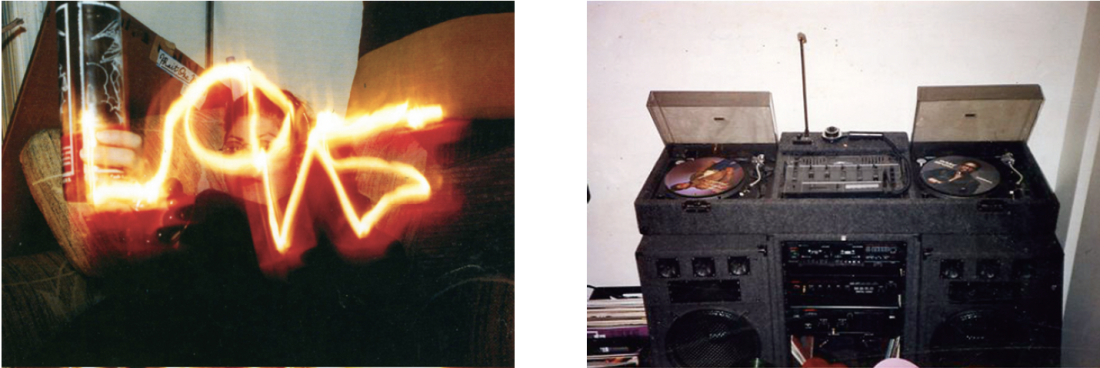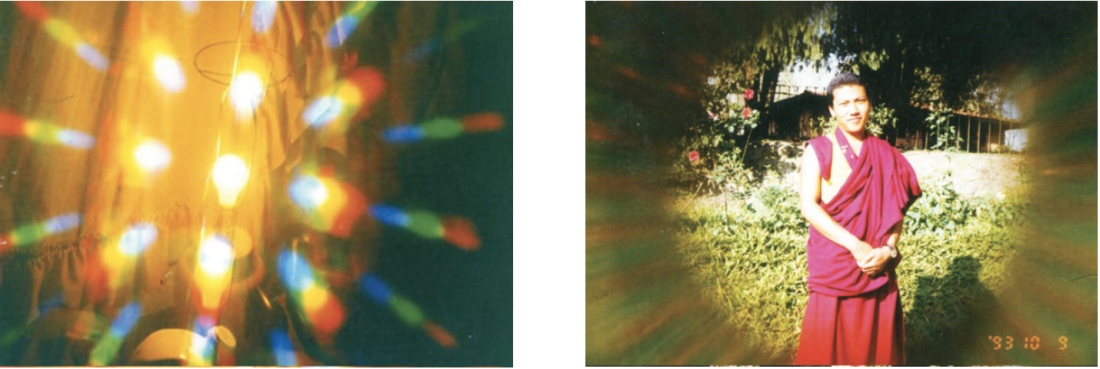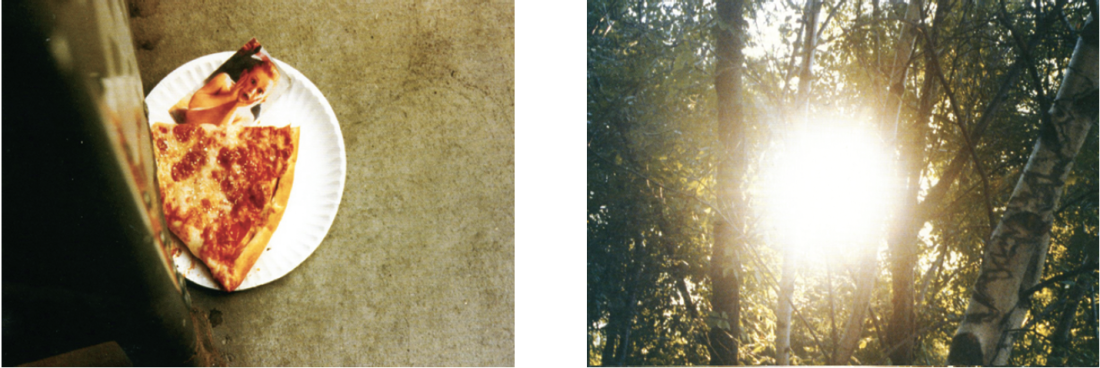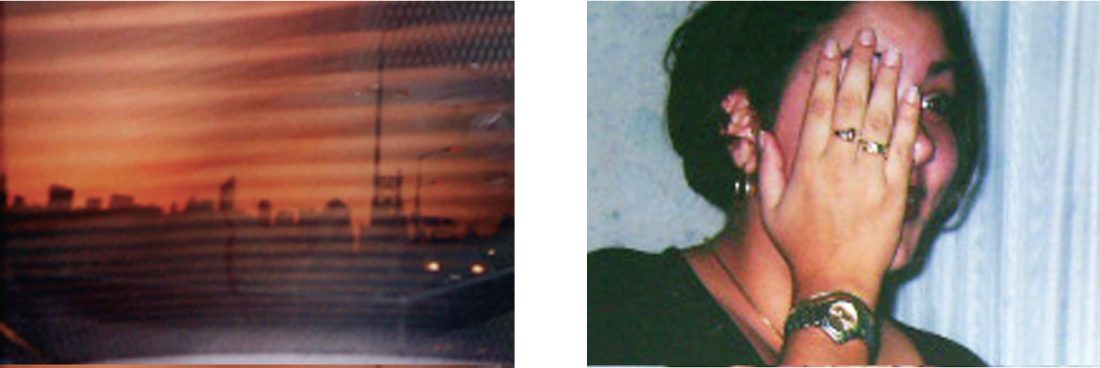Brian Belott

Brian Belott, selections of 1600 found photographs from “Lost and Found.” Images courtesy the artist and CANADA Gallery, New York.
Community Outreach is Paul Bright’s latest contribution to the cultural landscape in London, Ontario. Bright is a collector and musician who, through years spent travelling around the US, finding and selling pieces of mid-century modernist furniture and spending the proceeds on art, has built up both an impressive collection and a large circle of artist friends. The gallery is created in the same DIY spirit as an independent record label or drop-in centre and seems more likely in San Francisco or Brooklyn than in southwestern Ontario. Almost all the artists represented are part of the American post-theory, pseudo-psychedelic, collage, glitter and comics strain of art, which has strong ties to Rhode Island School of Design, Robert Crumb, Raymond Pettibon and our very own Royal Art Lodge. Upon entering the gallery, I passed through a small crowd of 20-somethings looking like a combination of Duran Duran, Patti Smith and the cast of Romper Room. One fellow sported a neon green baseball cap slanted sideways, Ray- Bans, and a fanny pack slung over super-tight jeans, resulting in a look somewhere between Bill Murray in Meatballs and a vaudevillian bad guy. I mention these observations to try to paint a picture of a space that is more than just a collection of objects on the wall; it is a kind of collective experience typified by the energy and bluster of many of Paul Bright’s youthful acolytes. The last few shows at Community Outreach have included well-known artists like Barry McGee, Amy Lockhart, Taylor McKimens, Ben Jones, Dearraindrop and Jason McLean. But the latest exhibit by New York-based Brian Belott seems to be moving the gallery beyond the scope of its often bawdy teenage drawing sensibility into something more ambitious and difficult.

Brian Belott, selections of 1600 found photographs from “Lost and Found.” Images courtesy the artist and CANADA Gallery, New York.
Brian Belott’s wildly eclectic practice includes performance, ongoing collage work, comics, paintings, found objects and numerous collaborations, as well as other less readily definable interventions like the now infamous YouTube clip where he lights his hair on fire. Lost and Found Slide Show is a version of a larger project entitled Wipe that Clock off your Face, which is a book that features some of his collage work, paintings and a DVD of found audio and photography. In one form or another, this work has already been exhibited in New York, London (UK), Paris and Stockholm. Belott’s more materially engaged paintings and collages initially read as shoddy, bumbling and chaotic, intentionally looking like they could be the byproduct of art therapy, kindergarten or art camp. They are purposefully stupid in a careful tripartite, anti-theoretical sense of the word: lacking intelligence (on purpose); dazed and unable to think properly (on purpose vis-à-vis chemicals); informal, used to express exasperation or boredom (unfortunate consequence of being too clever). Belott makes these collages in the full glare of artists like Kurt Schwitters, Picasso and Joseph Cornell, but without the slightest degree of embarrassment or the awkwardness that such direct and immediate imitation might usually engender. For they are not meant to read as singular expressions of creative “genius” or originality. They come out of dub, postproduction and mash-up. Belott isn’t simply trying to make Art but rather to rearrange the leftovers into a kind of encyclopedic catalogue of random resources that has the ability to retrieve a poetic individualism from the avalanche of cultural, physical and psychological detritus left behind in the wake of our contemporary consumer experience. And although at first I struggled to find the correlation between his rabid collages and paintings and the found audio and photo-work, as I looked longer, the connections were revealed as a notion of cataloguing and archiving.

Brian Belott, selections of 1600 found photographs from “Lost and Found.” Images courtesy the artist and CANADA Gallery, New York.
He likens himself to W.A. Bentley, who, through trial and error, succeeded, in 1885, in making the first photomicrograph of a snow crystal. Bentley saw each snowflake as infinitely beautiful and a masterpiece of design and lamented that when a snowflake melted, it was lost forever. Assembled over 10 years and consisting of innumerable found photographs and thousands of hours of found audio, Belott too is making a record of sorts from the discarded remains of existence. And like Bentley, his observation of the uniqueness of experience succeeds in registering a profoundly fleeting and fragile beauty. This project always hovers close to the edge of a sarcastic version of “Family of Man,” but is saved by Belott’s wickedly humorous eye and by the raw, unsophisticated quality of his found photographs.

Brian Belott, selections of 1600 found photographs from “Lost and Found.” Images courtesy the artist and CANADA Gallery, New York.
Down rickety steps into the basement of the gallery, I found the piece being projected on newly painted drywall. A recording from what sounds like someone playing a “bontempi” organ is almost blaring through an antiquated wooden record player cabinet. Like so many family slide shows in basements gone before, we are presented with a stream of projected still images, but in Belott’s show there are 1600 of them: a naked woman with a plaster cast on her leg (looking surprisingly like an image from Helmut Newton); a man passed out on the floor beside his uneaten dinner; fireworks; a double-exposed image of a Caribbean family picnic and a NYC cop; Santa; a coiled-up snake on a fake tiger-skin blanket; images of people obscured by a camera strap or thumb, or the flash reflecting off a mirror; kissing; mooning; more mooning; Billy Dee Williams (AKA Lando Calrissian) as a Christmas tree ornament; a double-exposed image of a girl in white T-shirt underneath a picture of Jesus and the same woman watersliding; campfires, drinking, kissing, more drinking, family pets, graduation, crotch shots, sunsets, and so on. In Belott’s world we are the overexposed skinny kid who doesn’t fill out her Lycra gym suit, or whose fat rolls over the sides of it. We have lame hairdos and dated the guy with the Camaro; our weddings are tacky; we cry at graduations. After watching the projection for an hour or so, the distinction between my memories and these images began to break down and I felt oddly connected to, and nostalgic about, the random, foreign, incomplete experiences of others. Belott’s “massive archival family photo album,” as he calls it, allows for a type of observation that slowly shifts from a titillating pastiche of embarrassing and overtly sentimental, almost snide, vignettes into something that carefully preserves “the viewer’s intense voyeuristic leap into found space.” Despite the relentlessly repeating arbitrary differences of each of these photos, the supervening result is similar to Bentley’s project: a study of subjects endlessly diverse, complicated and unique, yet in their infinite disparity only just snowflakes. ■
Brian Belott’s “Lost and Found Slideshow” was exhibited at Community Outreach in London, Ontario, from September 7 to October 5, 2007.
Sky Glabush is an artist and writer who lives in London, Ontario, and teaches at the University of Western Ontario.

